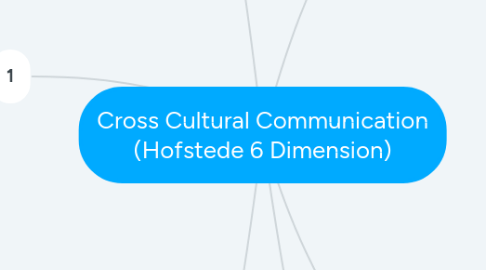
1. 2
1.1. High Power Distance
1.1.1. people in higher positions are more powerful
1.1.1.1. High hierarchy
1.1.1.2. higher level of respect
1.1.1.3. superior, equal or inferior
1.1.1.4. Refers to Last Name
1.1.2. Boss relations are emotional
1.1.3. employers do not question managers
1.1.3.1. leaders with authoritarian style
1.1.3.1.1. but paternalistic
1.1.3.2. lower levels of participation
1.1.4. Expect to be told what to do
1.1.5. Thailand, Turkey
1.2. Low Power Distance
1.2.1. egalitarianism
1.2.1.1. people are equal
1.2.2. Power to be used for specific purposes
1.2.3. Boss relations are practical
1.2.4. subordinated expect to be consulted
1.2.4.1. hiring process
1.2.4.2. decision making
2. 1
2.1. Individualist
2.1.1. task over relationship
2.1.1.1. relations are a contract
2.1.2. individuals
2.1.2.1. people take care of themselves
2.1.3. looser ties with groups
2.1.3.1. only nuclear family
2.1.3.2. change more often
2.1.4. autonomy
2.1.5. independence
2.1.6. everyone treated the same
2.1.7. USA, UK, Australia
2.2. Collectivist
2.2.1. relationship over task
2.2.1.1. relations are moral
2.2.2. strong bonds to groups
2.2.2.1. broader family
2.2.2.2. friends
2.2.3. group membership forms self identity
2.2.4. influence choices
2.2.4.1. career
2.2.4.2. spouse
2.2.5. being different from the group is undesirable
2.2.5.1. indirect ways of disagreeing
2.2.6. team-based rewards
2.2.7. in-group gets better treatment
2.2.8. China, Japan, Thailand, India, Latin America, Iran, Greece, Turkey
3. 4
3.1. Masculinity
3.1.1. value
3.1.1.1. achievement
3.1.1.2. competitiveness
3.1.1.3. acquisition of money
3.1.2. work is humanized by job enrichment
3.1.3. rewards based on equity
3.1.4. work prevails over family
3.1.5. separation of gender roles
3.1.5.1. men are more likely to be assertive and competitive
3.1.6. CEOs are better paid than managers
3.1.7. Japan, Hungary, Italy, UK
3.2. Femininity
3.2.1. value
3.2.1.1. good relantionships
3.2.1.2. care for others
3.2.1.3. quality of life
3.2.2. work is humanized thru social contact
3.2.3. rewards based on equality
3.2.4. family prevails over work
3.2.5. work arrangements are more common
3.2.6. Sweden, Netherlands, Norway
4. 3
4.1. High Uncertainty Avoidance
4.1.1. structure, rules and procedures
4.1.1.1. create procedures to deal with problems
4.1.1.2. write out expected behaviors
4.1.2. prefer predictable situations
4.1.2.1. avoid risky situations
4.1.2.2. reduce uncertainty
4.1.2.2.1. threat
4.1.2.3. do not like ambiguity
4.1.3. employers expect
4.1.3.1. clear set of instructions
4.1.3.2. clarity in expectations
4.1.4. employment contracts
4.1.5. believe in experts
4.1.6. focus on implementation
4.1.7. Germany, Greece, Latin America
4.2. Low Uncertainty Avoidance
4.2.1. life needs initiative
4.2.2. are not rule oriented
4.2.2.1. rules viewed as constrains
4.2.2.2. create a lot of exceptions
4.2.3. believe in common sense
4.2.4. focus on invention
4.2.5. Iran, Russia
5. 5
5.1. Long Term Orientation
5.1.1. the best is yet to come
5.1.2. lifelong personal networks
5.1.3. leisure time is less important
5.1.4. value
5.1.4.1. learning
5.1.4.2. honesty
5.1.4.3. discipline
5.2. Short Term Orientation
5.2.1. the future is now
5.2.2. personal loyalty depends on the situation
5.2.3. leisure time is very important
5.2.4. value
5.2.4.1. freedom
5.2.4.2. consumption
5.2.4.3. service
6. 6
6.1. Indulgence
6.1.1. allows relatively free gratification of basic and natural human drives related to enjoying life and having fun
6.2. Restraint
6.2.1. suppresses gratification of needs and regulates it by means of strict social norms
